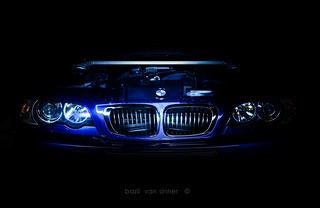Ακριβώς όπως το είπεςΤο σχεδιάσε, δεν έδωσε η BMW κανένα μοτέρ (π.χ όπως στα Pagani η Mercedes)
https://www.audiosignal.co.uk/McLarenF1.htmlENGINE
Although it is the numbing 627bhp peak power of the F1Άs engine (codenamed S70/2 within BMW) which garners headlines, in many ways that represents the least of the challenges which faced the design team. The fact that the 550bhp originally demanded by Murray has been exceeded by a comfortable 14 per cent proves the point.
It was in other respects that BMWΆs considerable experience in designing road and race engines was to prove invaluable. Firstly, Murray set the length and weight — 600mm block length and 250kg (to include all ancillaries, the exhaust and silencer). It finished up the correct length and only slightly too heavy (by 16kg). Secondly, this prodigious powerplant had to be rendered thoroughly user-friendly so it could trickle along in traffic as willingly as it would thunder along autobahns.
It is natural to regard any powerplant capable of delivering 627bhp and 500lb ft of torque (about 50 per cent more than a modern Formula One engine, incidentally) as a thoroughbred race unit, but thatΆs not so. It is instructive to compare the S70/2 with one of BMW MotorsportΆs less exotic creations, the six-cylinder engine fitted to the M3. In most key areas — specific output, specific torque, peak power revs, bore/stroke ratio and compression ratio — the two units are matched to within 5 per cent Only in its length and weight does the F1 unit set itself significantly apart.
This is what you would expect of an engine which, in addition to being road-tractable, must be moderately stressed for a long service life and practicable maintenance schedules. In the course of its development the F1 engine was put through the same punishing 500-hoor bench test as all BMW road-going powerplants, and its nominal service interval is 5000 miles.
Emissions performance has not been compromised either. As in the M3 engine, secondary air injection is used to reduce pollutant levels during the critical warm-up phase. Until the four catalytic converters reach light-off — relatively quickly since they are closer-coupled in the F1 than in the M3 — air is injected into the exhaust manifold to burn off excess hydrocarbons produced by cold start over-fuelling.
It is a reflection of its short development time that the F1 engine uses, in the main, only tried and trusted technology from BMWΆs mainstream units. The variable valve timing, for example, is closely based on the VANOS system used in the M3. This simple, hydraulically-actuated phasing mechanism retards the inlet cam relative to the exhaust cam at low revs, reducing valve overlap and ensuring good idle behaviour and low-speed torque. Higher up the rev range, under the control of the engine management computer, the valve overlap is increased by 42 degrees (25 degrees in the M3) to improve engine breathing and maximise power output.
Despite their common valvetrain technology, though, the F1 and M3 engines are tuned for significantly different torque characteristics. Whereas the M3Άs torque curve has its maximum at 3600rpm and is virtually a plateau from 3500rpmto almost 6000rpm, the F1Άs displays instead the inexorable climb of a traditional sporting engine, peaking at 5600rpm, only 1600rpmBelow peak power output. The F1 unit delivers a beefy 398lb ft at 1500rpm even so— 69 per cent greater than the M3Άs peak output and quite sufficient to ensure vivid performance in a car weighing around 1200kg including driver.
In fact, ensuring that the F1 was not over-willing on small throttle openings posed one of the principal development difficulties. Making the engine fuss-free in traffic was not enough; it also had to be sufficiently controllable not to bury the car under the lorry in front at the merest twitch of the loud pedal. Careful design of the throttle linkage and TAGΆs expertise in engine management were relied upon to achieve this.
Although considerable attention was paid to the induction system (length, diameter and surface finish of the inlet tracts, and the volume of the plenum chamber) variable geometry was resisted by BMW as an unnecessary complication.
A familiar problem in high-speed racing engines is mixture preparation. At the high inlet air speeds encountered at high revs there is insufficient time for the fuel to atomise fully if the injector is placed close to the inlet valve, as it is normally is in road engines with multi-point injection.
Although the F1 engine runs at nothing like the 13,000rpm-plus of state-of-the-art racing engines like the Ford HB, BMWΆs engineers found that mixture preparation from a single injector was not ideal across the whole rev band, so two Lucas injectors are used per cylinder. The first, positioned close to the inlet valve, operates at low engine speeds while the second, positioned further up the inlet tract, takes over at high revs. A soft transition between the two, controlled by the engine management computer, covers up the switch-over.
Mixture preparation is further improved in the lower injector by air assistance. A narrow jet of air, drawn into the inlet tract by the partial vacuum created on the induction stroke, ΅shearsΆ the fuel spray and breaks it up into smaller droplets.
As you would anticipate in an engine of this sophistication, the closed-loop fuel injection is sequential. Fully mapped, contactless ignition is likewise no less than you would expect, each cylinder having its own miniature ignition coil, just as in the M5. Engine load is sensed by hot wire. Combustion conditions are sufficiently remote from knock limits that no knock sensor is necessary.
The materials usage in this engine, like the core technology, is also relatively conservative, drawing again on BMWΆs production engines. No titanium valves or conrods here. Both the head and block are cast in aluminium, with a Nicasil coating to the cylinder bores providing the necessary wear resistance. The lightweight pistons are of forged aluminium, the con rods and the crank of forged and twisted steel, and the exhaust valves are sodium cooled. Significantly, most of these features can be found in the M5 powerplant.
One notable exception is the exhaust system, a bulky and potentially heavy item constructed, from the block to the silencer, of Inconel, a particularly durable, heat resistant grade of stainless steel which allows the use of a thinner pipe gauge (0.8mm). Further weight saving is achieved by making the large 65-litre silencer of titanium and having it double up as a crush member for rear impacts.
A race engine feature which Murray did insist on for the F1 was minimal flywheel effect. What the clutch mounts to is an aluminium plate no larger or thicker than necessary to transmit the engineΆs torque, and which has minimal rotational inertia. This should endow the V12 with exceptional throttle response and rapid rev shedding on lift-off, permitting the fastest possible gear changes. Of course, this is only feasible in an engine without secondary vibrational couples (hence the pure 60-degree vee angle) and which is carefully balanced, otherwise the level of engine vibration would he unacceptable. BMW has also fitted a torsional vibration damper.
A second race car feature, found on very few road cars, is dry sump lubrication. Although more complex and costly than a conventional wet sump, it shaves vital inches from the height of the oil pan and so allows the engine to be mounted lower.
:sorry: για το offtopic












 Απάντηση με παράθεση
Απάντηση με παράθεση


 ... αν μπορει καποιος να το αντεξει αυτο οκ !!!
... αν μπορει καποιος να το αντεξει αυτο οκ !!! 

